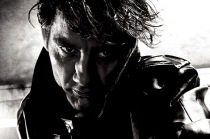MOVING PICTURES
It's revenge time, baby! The fact that Hollywood-rogue Robert Rodriguez even decided to leave the Director's Guild of America to be able to realize Sin City in the way he imagined it (and assign co-director's credit to Frank Miller, author of the graphic novels) shows that this is a project dear to his heart. The following review tries to shed some light on the question whether it has the potential to become dear to anyone else.
Adaptations of comic books and graphic novels have a long history in US cinema, and different filmmakers have selected various approaches to this form. The earliest was to simply take the silly, colorful decor right from the pages, unleash it on actors who had nothing better to do on Friday nights and film this in a thoroughly earnest manner. The result was often rather unintentionally funny than anything else. Later ventures, such as the high-
 profile adaptation of the United States' number one superhero, Superman, also known as "the man of steel", retained the absurd costumes, but tried to deflect a bit more from them by putting the characters into realistic-looking environments or spending shitloads of money on the visual effects. In the late 1980s, Tim Burton's Batman revived the initial comic-style in a grittier version, but at the same time descended into postmodernism by making it an exuberant, self-conscious, ironic play of stylish forms.
"Gritty" was also the term applied to the latest trend of comic book movies spawned by Bryan Singer and his X-Men franchise at the turn of the century, who reduced Burton's self-conscious irony to a few witty wisecracks and primarily used bleak, often dark and dirty real-world imagery, putting his films more into the tradition of conventional science-fiction-fantasy-hybrids. And finally, there are the adaptations of realistically-themed, adult-oriented graphic novels such as From Hell or Road to Perdition which are filmed in such a thoroughly benign way – as one might film a story based on a novel – that many of us would not even know their origin if the credits did not care to tell us.
profile adaptation of the United States' number one superhero, Superman, also known as "the man of steel", retained the absurd costumes, but tried to deflect a bit more from them by putting the characters into realistic-looking environments or spending shitloads of money on the visual effects. In the late 1980s, Tim Burton's Batman revived the initial comic-style in a grittier version, but at the same time descended into postmodernism by making it an exuberant, self-conscious, ironic play of stylish forms.
"Gritty" was also the term applied to the latest trend of comic book movies spawned by Bryan Singer and his X-Men franchise at the turn of the century, who reduced Burton's self-conscious irony to a few witty wisecracks and primarily used bleak, often dark and dirty real-world imagery, putting his films more into the tradition of conventional science-fiction-fantasy-hybrids. And finally, there are the adaptations of realistically-themed, adult-oriented graphic novels such as From Hell or Road to Perdition which are filmed in such a thoroughly benign way – as one might film a story based on a novel – that many of us would not even know their origin if the credits did not care to tell us.
Now comes Robert Rodriguez and, casually spitting on all the thoughts other filmmakers have wasted over the years on how to transfer drawing to screen, chooses the most straightforward and at the same time the most vanguard approach yet: He simply took the cells of Frank Miller's Sin City graphic novels one by one and reproduced them on the screen – and he did this witch such precision that there was not even the need for a storyboard to create this motion picture.
Motion picture – a term that seems to be tailor-made for Sin City or at least receives new meaning from it. Never before could the idea of "moving pictures" be taken so literally. Through a combination of masterful achievements in make-up and costume design as well as solid to remarkably strong
 performances, the characters seem to have leapt right off the pages and come to life. In fact, that is true of the entire shots, since all actors were filmed primarily against bluescreens and superimposed on heavily stylized, computer generated backgrounds. Even those scenes that were filmed in real sets have been put through a variety of digital post-processing techniques, arranging them in a unique black-and-white look with the dark and bright spaces juxtaposed in extreme contrasts. Only occasionally a splash of color gets lost in this "film noir to the max" to emphasize certain special features.
At times this can be something like the blonde hair of dancer Nancy, but mostly it is the excessive amounts of blood flowing onscreen when Marvin goes on his revenge rampage.
performances, the characters seem to have leapt right off the pages and come to life. In fact, that is true of the entire shots, since all actors were filmed primarily against bluescreens and superimposed on heavily stylized, computer generated backgrounds. Even those scenes that were filmed in real sets have been put through a variety of digital post-processing techniques, arranging them in a unique black-and-white look with the dark and bright spaces juxtaposed in extreme contrasts. Only occasionally a splash of color gets lost in this "film noir to the max" to emphasize certain special features.
At times this can be something like the blonde hair of dancer Nancy, but mostly it is the excessive amounts of blood flowing onscreen when Marvin goes on his revenge rampage.
Sin City does not have a single storyline but contains several episodes, each of which was a graphic novel of its own originally. They are fairly conventional (but of course thoroughly over the top) film noir tales, bound together by the common theme of what happens when, in a city of crime, the careful balance of power between different kinds of crooks is upset by the last people in town who still possess a shred of decency. The best of these stories definitely is the one featuring the incredibly ugly ex-convict Marvin who finds unexpected love with the prostitute Goldie – only to wake up with her dead body in his bed on the next morning, already framed for the murder. Out for revenge, he uncovers a web of different plots among the city's most powerful, and leaves an absurd amount of dead bodies behind on the way, along with some of the most excessively violent killing methods ever seen (made bearable only through the strong stylization) and a number of highly memorable lines.
The second tale centers on Dwight, a criminal back in town with a new face, who helps a company of self-employed prostitutes to defend themselves from a brutal police regime. Though certainly not boring, this episode can be somewhat tiring at times, lacking the zest and energy of the Marvin segment, but due to the same cynicism and exaggerated wise-cracking is similarly unable to evict a truly dramatic emotional response. On the other hand, both of these episodes did manage to make me think about myself when they provoked intentional laughs during some of the most violent scenes – and that is something few films achieve.
The only story that has the potential to go straight to the heart is the one framing it all about aging cop Hartigan who shakes pedophile Roark Jr. down for his most valuable parts to protect the little girl Nancy. But luck is not on his side, since the pervert is the son of the city's most powerful man. Sentenced to a long time in jail, Hartigan's first thought when he comes out of prison is to protect the now nineteen-year-old Nancy who works as a dancer. Roark Jr., mutated into the deformed "Yellow Bastard" by his attempts to regrow what
 he has lost, has sworn to finish what he started, so Hartigan has to go on a self-sacrificial journey to rid the world of him once and for all.
he has lost, has sworn to finish what he started, so Hartigan has to go on a self-sacrificial journey to rid the world of him once and for all.
Although the overall film feels somewhat distanced and sometimes – despite the buckets of blood – cold due to its unreal look and usually unabashedly cynical view on life, it nevertheless has the undeniable feel of a classic in the making. It certainly emphasizes style over substance, but who cares when this style can occasionally – when there are no heads being ripped off bodies for a change – produce images of truly poetic beauty, like perfectly white snow falling against a pitch-black sky with a melancholic black-and-white Hartigan walking through it. Being a personal friend of George Lucas, it comes as no surprise that Robert Rodriguez decided to shoot his movie entirely digital, with the usual effect that it looks good on film but is nothing short of breathtakingly gorgeous when projected in the appropriate manner. Highly recommended!